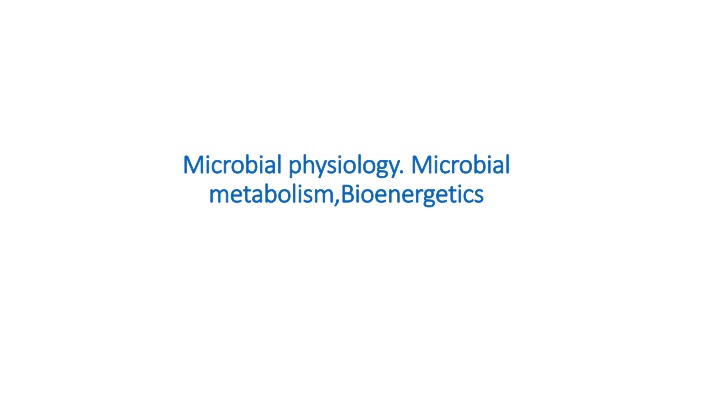
Microbial Physiology and Metabolism
Explore the fascinating world of microbial physiology and metabolism, including electron transport systems, anaerobic respiration, fermentation, and metabolic strategies. Learn how microbes utilize different pathways to generate energy and adapt to varying environmental conditions.
Download Presentation

Please find below an Image/Link to download the presentation.
The content on the website is provided AS IS for your information and personal use only. It may not be sold, licensed, or shared on other websites without obtaining consent from the author. If you encounter any issues during the download, it is possible that the publisher has removed the file from their server.
You are allowed to download the files provided on this website for personal or commercial use, subject to the condition that they are used lawfully. All files are the property of their respective owners.
The content on the website is provided AS IS for your information and personal use only. It may not be sold, licensed, or shared on other websites without obtaining consent from the author.
E N D
Presentation Transcript
Microbial physiology. Microbial Microbial physiology. Microbial metabolism,Bioenergetics metabolism,Bioenergetics
3. Electron Transport System Occurs within the cell membrane of Bacteria Chemiosomotic Model of Mitchell 34 ATP
Anaerobic respiration Utilizes same Three coupled pathways as Aerobic Respiration Used as an alternative to aerobic respiration Final electron acceptor something other than oxygen: NO3- : Pseudomonas, Bacillus. SO4-: Desulfovibrio CO3-: methanogens In Facultative organisms In Obligate anaerobes Lower production of ATP because only part of the TCA cycle and the electron transport chain operate.
Fermentation Fermentation Incomplete oxidation of glucose or other carbohydrates in the absence of oxygen Uses organic compounds as terminal electron acceptors Effect - a small amount of ATP Production of ethyl alcohol by yeasts acting on glucose Formation of acid, gas & other products by the action of various bacteria on pyruvic acid
Metabolic strategies Pathways Pathways involved involved Final e Final e- - acceptor acceptor ATP yield ATP yield Aerobic Aerobic respiration respiration Glycolysis, TCA, ET O2 38 NO3-, So4-2, CO3-3 Anaerobic Anaerobic respiration respiration Glycolysis, TCA, ET variable Organic molecules Fermentation Fermentation Glycolysis 2
Many pathways of metabolism are bi-directional or amphibolic Metabolites can serve as building blocks or sources of energy Pyruvic acid can be converted into amino acids through amination Amino acids can be converted into energy sources through deamination Glyceraldehyde-3-phosphate can be converted into precursors for amino acids, carbohydrates and fats
Redox reactions Always occur in pairs. There is an electron donor and electron acceptor which constitute a redox pair. Released energy can be captured to phosphorylate ADP or another compound.
Basic reaction : electron uptake Biological reaction : electron removal
ATP Three part molecule consisting of adenine a nitrogenous base ribose a 5-carbon sugar 3 phosphate groups Removal of the terminal phosphate releases energy Adenosine Tri Phosphate ADP + energy + phosphate ATP contains energy that can be easily released (high- energy or unstable energy bond) Required for anabolic reactions
Formation of ATP 1.substrate-level phosphorylation 2.oxidative phosphorylation, (reduced chemicals) Uses of ATP: Energy for active transport Energy for movement Energy for synthesis of cellular components ALL SYNTHESIS REACTIONS INVOLVE USE OF ENERGY
Lipid Metabolism Lipids are essential to the structure and function of membranes Lipids also function as energy reserves, which can be mobilized as sources of carbon 90% of this lipid is triacyglycerol triacyglycerol lipase glycerol + 3 fatty acids The major fatty acid metabolism is -oxidation
Lipid catabolism Lipid catabolism Lipids are broken down into their constituents of glycerol and fatty acids Glycerol is oxidised by glycolysis and the TCA cycle Lipids are broken down to 2 carbon acyl units where they enter the TCA cycle
PROTEIN CATABOLISM PROTEIN CATABOLISM proteins cannot cross bacterial plasma membrane, so bacteria must produce extracellular enzymes called proteases and peptidases that break down the proteins into amino acids, which can enter the cell. Many of the amino acids are used in building bacterial proteins, but some may also be broken down for energy. If this is the way amino acids are used, they are broken down to some form that can enter the Kreb s cycle. These reactions include: 1.Deamination the amino group is removed, converted to an ammonium ion, and excreted. 2. Decarboxylation the ---COOH group is removed 3. Dehydrogenation a hydrogen is removed Tests for the presence of enzymes that allow various amino acids to be broken down are used in identifying bacteria in the lab.
Protein Catabolism Protein Catabolism
